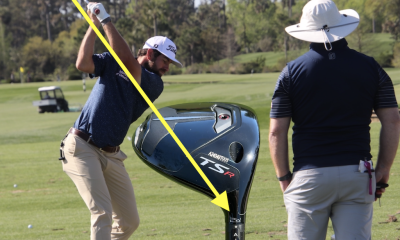Opinion & Analysis
A True Story About Putters (Part 2)

In my previous article, I told the true story of when I encountered a “genius IQ” and his putter design. In our conversation, I pointed out a major flaw, whereupon he decided that the flaw was me and our relationship was short lived.
Let’s change the outcome for the purposes of looking at putters as a product. For my standard fee of a dozen golf balls, I’ve agreed to offer advice to help this inventor and his backers. Starting with the putter itself, our final head design ended as technically perfect as modern science could produce. And let me be clear here, I’m NOT going into detail about the putter — that really isn’t the point of the story.
I could describe the optimal dwell time on the face supplied by grooved inserts, the inertial factors as described by weight distribution, available lofts, custom fitting options, a variety of grips — the best of the best — and test data to show why. Someone will probably comment that I didn’t include X, and my answer is, “Yes we did.” I repeat, it’s the perfectly designed putter.
I want to emphasize what I’ve written. There are dozens if not hundreds of putter designers who honestly believe they have a better product. I’m saying, “Fine, I agree.” We are starting this with the best.
The term “the best” is a very narrow window. There are putters used on Tour that are more than 20 years old (more than 70 years old if you count the Bulls Eye). Are they technically inferior? Let’s match the confidence someone has using his 20-year-old putter under pressure versus something ultra modern that doesn’t deliver the same reassurance. I’m not anti-technology. I’m pointing out that the final environment is both inconsistent (because of the green surfaces) and highly psychological. Since we’re dealing with humans, it’s unavoidable.
Now what? My genius friend and his backers are not dreamers. They desire a commercial success. That means one thing, get the putter used on Tour. It’s very simple in the mind of the consumer. If the folks making a living use it then there must be value, and if not it’s just another putter.
There is a Plan B: Millions of dollars spent on advertising in an attempt to convince consumers that the putter is superior regardless of Tour usage. The track record for this approach would have to be upgraded to unsuccessful. Taking my advice, it’s a non-strategy.
So it’s the Tour. How do we start? Tour players on a putting green are in their office and as such do not care to be interrupted. That said, there is a Tuesday window for experimentation, but access is the challenge. We are non-entities wandering around with putters — no credentials, thus no access. If we knew who, we could look for a tour rep and find one who would give us reasonable access, so let’s assume that is the case.
This rep has the job of convincing Tour players to try the putter while telling them about its superior technical merits. This is very difficult. There are several independent putter reps all with the same objective, and the companies that make the brands the players use have reps out there making sure they don’t switch. With putters, the players are interested in the look at address, feel and how the ball rolls. The overwhelming majority could care less about the technical story involving the design. They are the ultimate lab and if they say the putter looks funny or feels bad, it’s branded. Game over!
But we are on a roll (sorry couldn’t help myself), our rep gets the putter in the hands of a couple of guys who have been struggling on the greens and they use it in the Wednesday Pro-Am. Let’s say they make a couple of bombs, don’t miss any short ones and the putter goes in their bag.
Isn’t this exactly what we wanted? The answer is partially. You see, getting the putter on Tour isn’t enough. It’s Step 1, but success means several players using our putter and the reason is television. One or two players have low odds of TV time, but several means we have a chance.
In our perfect scenario, these two guys have to putt so well that other players notice and pretty soon we have a dozen, maybe even 20 even players using our putter, and our phone is ringing with their agents asking about playing contracts. Now we have arrived!
Not exactly.
The design of the putter must be such that when used on TV it is so unique that viewers instantly recognize it in their favorite golf store. Want a perfect example? Odyssey putters were not only uniquely identifiable, but told a visual story, alignment. Their overwhelming success completely disrupted the putter market.
My genius friend has a unique design, but it’s not visual enough to jump off the TV screens. This is a critical juncture. The product is good, it has some tour success now the consumer must be “educated.” Two words, BIG Money. And remember that it takes at least two or three years for the message to fully penetrate the minds (and wallets) of the consumer.
At this juncture, I’d advise my friend and his backers not to jump into the putter business, but approach the big companies and shoot for a royalty deal.
The “big guys” have seen this movie, and they are busy dissecting the design and patent to see where they could compete if they choose. They have staffs of engineers to assign to the project and not just the design in hand, but a succession of variations. They want to make money and will make a deal; you have to be able to define what is acceptable.
This exact scenario is the major reason why nearly all independent putter companies that have tried to compete directly with the major equipment companies have gone broke or sold for a value less than the original investment.
I would strongly advise the genius and his group to have an excellent website, tell of the Tour success (and be prepared to pay tour contracts for continued usage) and try and build a consumer groundswell. In the world of introducing a new putter that’s a win, and the big guys are aware.
Opinion & Analysis
The 2 primary challenges golf equipment companies face

As the editor-in-chief of this website and an observer of the GolfWRX forums and other online golf equipment discourse for over a decade, I’m pretty well attuned to the grunts and grumbles of a significant portion of the golf equipment purchasing spectrum. And before you accuse me of lording above all in some digital ivory tower, I’d like to offer that I worked at golf courses (public and private) for years prior to picking up my pen, so I’m well-versed in the non-degenerate golf equipment consumers out there. I touched (green)grass (retail)!
Complaints about the ills of and related to the OEMs usually follow some version of: Product cycles are too short for real innovation, tour equipment isn’t the same as retail (which is largely not true, by the way), too much is invested in marketing and not enough in R&D, top staffer X hasn’t even put the new driver in play, so it’s obviously not superior to the previous generation, prices are too high, and on and on.
Without digging into the merits of any of these claims, which I believe are mostly red herrings, I’d like to bring into view of our rangefinder what I believe to be the two primary difficulties golf equipment companies face.
One: As Terry Koehler, back when he was the CEO of Ben Hogan, told me at the time of the Ft Worth irons launch, if you can’t regularly hit the golf ball in a coin-sized area in the middle of the face, there’s not a ton that iron technology can do for you. Now, this is less true now with respect to irons than when he said it, and is less and less true by degrees as the clubs get larger (utilities, fairways, hybrids, drivers), but there remains a great deal of golf equipment truth in that statement. Think about it — which is to say, in TL;DR fashion, get lessons from a qualified instructor who will teach you about the fundamentals of repeatable impact and how the golf swing works, not just offer band-aid fixes. If you can’t repeatably deliver the golf club to the golf ball in something resembling the manner it was designed for, how can you expect to be getting the most out of the club — put another way, the maximum value from your investment?
Similarly, game improvement equipment can only improve your game if you game it. In other words, get fit for the clubs you ought to be playing rather than filling the bag with the ones you wish you could hit or used to be able to hit. Of course, don’t do this if you don’t care about performance and just want to hit a forged blade while playing off an 18 handicap. That’s absolutely fine. There were plenty of members in clubs back in the day playing Hogan Apex or Mizuno MP-32 irons who had no business doing so from a ballstriking standpoint, but they enjoyed their look, feel, and complementary qualities to their Gatsby hats and cashmere sweaters. Do what brings you a measure of joy in this maddening game.
Now, the second issue. This is not a plea for non-conforming equipment; rather, it is a statement of fact. USGA/R&A limits on every facet of golf equipment are detrimental to golf equipment manufacturers. Sure, you know this, but do you think about it as it applies to almost every element of equipment? A 500cc driver would be inherently more forgiving than a 460cc, as one with a COR measurement in excess of 0.83. 50-inch shafts. Box grooves. And on and on.
Would fewer regulations be objectively bad for the game? Would this erode its soul? Fortunately, that’s beside the point of this exercise, which is merely to point out the facts. The fact, in this case, is that equipment restrictions and regulations are the slaughterbench of an abundance of innovation in the golf equipment space. Is this for the best? Well, now I’ve asked the question twice and might as well give a partial response, I guess my answer to that would be, “It depends on what type of golf you’re playing and who you’re playing it with.”
For my part, I don’t mind embarrassing myself with vintage blades and persimmons chasing after the quasi-spiritual elevation of a well-struck shot, but that’s just me. Plenty of folks don’t give a damn if their grooves are conforming. Plenty of folks think the folks in Liberty Corner ought to add a prison to the museum for such offences. And those are just a few of the considerations for the amateur game — which doesn’t get inside the gallery ropes of the pro game…
Different strokes in the game of golf, in my humble opinion.
Anyway, I believe equipment company engineers are genuinely trying to build better equipment year over year. The marketing departments are trying to find ways to make this equipment appeal to the broadest segment of the golf market possible. All of this against (1) the backdrop of — at least for now — firm product cycles. And golfers who, with their ~15 average handicap (men), for the most part, are not striping the golf ball like Tiger in his prime and seem to have less and less time year over year to practice and improve. (2) Regulations that massively restrict what they’re able to do…
That’s the landscape as I see it and the real headwinds for golf equipment companies. No doubt, there’s more I haven’t considered, but I think the previous is a better — and better faith — point of departure when formulating any serious commentary on the golf equipment world than some of the more cynical and conspiratorial takes I hear.
Agree? Disagree? Think I’m worthy of an Adam Hadwin-esque security guard tackle? Let me know in the comments.
@golfoncbs The infamous Adam Hadwin tackle ? #golf #fyp #canada #pgatour #adamhadwin ? Ghibli-style nostalgic waltz – MaSssuguMusic
Podcasts
Fore Love of Golf: Introducing a new club concept

Episode #16 brings us Cliff McKinney. Cliff is the founder of Old Charlie Golf Club, a new club, and concept, to be built in the Florida panhandle. The model is quite interesting and aims to make great, private golf more affordable. We hope you enjoy the show!
Opinion & Analysis
On Scottie Scheffler wondering ‘What’s the point of winning?’

Last week, I came across a reel from BBC Sport on Instagram featuring Scottie Scheffler speaking to the media ahead of The Open at Royal Portrush. In it, he shared that he often wonders what the point is of wanting to win tournaments so badly — especially when he knows, deep down, that it doesn’t lead to a truly fulfilling life.
View this post on Instagram
“Is it great to be able to win tournaments and to accomplish the things I have in the game of golf? Yeah, it brings tears to my eyes just to think about it because I’ve literally worked my entire life to be good at this sport,” Scheffler said. “To have that kind of sense of accomplishment, I think, is a pretty cool feeling. To get to live out your dreams is very special, but at the end of the day, I’m not out here to inspire the next generation of golfers. I’m not out here to inspire someone to be the best player in the world, because what’s the point?”
Ironically — or perhaps perfectly — he went on to win the claret jug.
That question — what’s the point of winning? — cuts straight to the heart of the human journey.
As someone who’s spent over two decades in the trenches of professional golf, and in deep study of the mental, emotional, and spiritual dimensions of the game, I see Scottie’s inner conflict as a sign of soul evolution in motion.
I came to golf late. I wasn’t a junior standout or college All-American. At 27, I left a steady corporate job to see if I could be on the PGA Tour starting as a 14-handicap, average-length hitter. Over the years, my journey has been defined less by trophies and more by the relentless effort to navigate the deeply inequitable and gated system of professional golf — an effort that ultimately turned inward and helped me evolve as both a golfer and a person.
One perspective that helped me make sense of this inner dissonance around competition and our culture’s tendency to overvalue winning is the idea of soul evolution.
The University of Virginia’s Division of Perceptual Studies has done extensive research on reincarnation, and Netflix’s Surviving Death (Episode 6) explores the topic, too. Whether you take it literally or metaphorically, the idea that we’re on a long arc of growth — from beginner to sage elder — offers a profound perspective.
If you accept the premise literally, then terms like “young soul” and “old soul” start to hold meaning. However, even if we set the word “soul” aside, it’s easy to see that different levels of life experience produce different worldviews.
Newer souls — or people in earlier stages of their development — may be curious and kind but still lack discernment or depth. There is a naivety, and they don’t yet question as deeply, tending to see things in black and white, partly because certainty feels safer than confronting the unknown.
As we gain more experience, we begin to experiment. We test limits. We chase extreme external goals — sometimes at the expense of health, relationships, or inner peace — still operating from hunger, ambition, and the fragility of the ego.
It’s a necessary stage, but often a turbulent and unfulfilling one.
David Duval fell off the map after reaching World No. 1. Bubba Watson had his own “Is this it?” moment with his caddie, Ted Scott, after winning the Masters.
In Aaron Rodgers: Enigma, reflecting on his 2011 Super Bowl win, Rodgers said:
“Now I’ve accomplished the only thing that I really, really wanted to do in my life. Now what? I was like, ‘Did I aim at the wrong thing? Did I spend too much time thinking about stuff that ultimately doesn’t give you true happiness?’”
Jim Carrey once said, “I think everybody should get rich and famous and do everything they ever dreamed of so they can see that it’s not the answer.”
Eventually, though, something shifts.
We begin to see in shades of gray. Winning, dominating, accumulating—these pursuits lose their shine. The rewards feel more fleeting. Living in a constant state of fight-or-flight makes us feel alive, yes, but not happy and joyful.
Compassion begins to replace ambition. Love, presence, and gratitude become more fulfilling than status, profits, or trophies. We crave balance over burnout. Collaboration over competition. Meaning over metrics.
Interestingly, if we zoom out, we can apply this same model to nations and cultures. Countries, like people, have a collective “soul stage” made up of the individuals within them.
Take the United States, for example. I’d place it as a mid-level soul: highly competitive and deeply driven, but still learning emotional maturity. Still uncomfortable with nuance. Still believing that more is always better. Despite its global wins, the U.S. currently ranks just 23rd in happiness (as of 2025). You might liken it to a gifted teenager—bold, eager, and ambitious, but angsty and still figuring out how to live well and in balance. As much as a parent wants to protect their child, sometimes the child has to make their own mistakes to truly grow.
So when Scottie Scheffler wonders what the point of winning is, I don’t see someone losing strength.
I see someone evolving.
He’s beginning to look beyond the leaderboard. Beyond metrics of success that carry a lower vibration. And yet, in a poetic twist, Scheffler did go on to win The Open. But that only reinforces the point: even at the pinnacle, the question remains. And if more of us in the golf and sports world — and in U.S. culture at large — started asking similar questions, we might discover that the more meaningful trophy isn’t about accumulating or beating others at all costs.
It’s about awakening and evolving to something more than winning could ever promise.






















Walter Pendleton
Jun 24, 2015 at 1:33 pm
Mr. Adams…you made an excellent point in this article when you said, Odessey CHANGED THE WORLD when they acknowledged alignment was the cornerstone of putting. You are so right Mr. Adams! However, I would like to add or comment that the USGA & R&A restrictions on “putter design” have stifled putting improvement by the average golfer and secondly has been counter productive to growing the game. Bear with me please as I defend my position on the subject. Image for a minute there were no restrictions on putter design, the average player’s handicap fell by 10 strokes and PGA players could score 58 or 59 regularly on tour? Wouldn’t more people enjoy the game, play more golf and buy more putters? I’m almost through…if the objective is to preserve the game, as it was founded some 500 years ago, then lets bring back the 12 original rules of golf and through away the dogma or bible called “The Rules of Golf.” My point is, we ALL know putting is 43% of every shot hit by the average player! If we don’t make putting more fun and golf easier, we risk the game of golf becoming a driving range sport due to its cost, like Japan, here in the United States. No one wants golf to return to its elitist status as a sport. That’s the elephant in the room no one wants to print or talk about in today’s world of golf. In fact, we all know its heading in that direction today! In closing I’ll just say, “Change is the only absolute in this world we know is going to happen…why not look at easing up on the poor golfer that three putts every fourth hole and never makes a fifteen footer! Good design, is just good business!
Regis
Feb 4, 2015 at 1:20 pm
So true Barney. Best putter story ever of course is the Nicklaus Response putter. He used it on somewhat of a lark to win the 1986 Masters. Had a very unique look given the time period involved. MacGregor had forecasted selling 6,000 units total But, Nicklaus’ victory was enough to turn a company forecast of 6,000 putters into sales of 350,000 units by the end of the 1987. In fact, the company received 5,000 orders before noon the day after the Masters. ,
Waqar
Jan 26, 2015 at 9:53 am
The picture above is the Borcerri Golf putter. It has the deepest face of any putter, as high as agolf ball.
I got impact tape and put on the face of my Scottie and putted for 10 mins. To my surprise I noticed that I was stroking my putts in the center but high on the face, at times at the top edge. I putt with ball in the middle of my stance because it helps me with alignment and I tend to pull if I move forward and push if it move it back. The sweet spot is in the middle of the putter face vertically and horizontally. For me to strike the ball in the middle of the face vertically I have to move the ball at least two balls forward and this will result in pulls.
I was an accomplished snooker and pool player. I tend to look at putting as a queue striking a ball. In pool to put topspin one needs to strike the ball above the equator or the queue tip has to be above the the butt end, which it not possible to do. With almost all putters made today one has to strike the ball just below the equator with positive loft and on the sweet spot. The amount of top spin also significantly depends on the softness of the ball cover, friction available on the putter face, and softness of putter face.
For the few gifted individuals, and professionals who spend hours upon hours grooving in a stroke to achieve to stroke the ball on the putter’s sweet spot with positive loft at or just below the equator with the putter face square to the intended line, 90% of the putters are simply not suitable.
Another thing that perplexes me is, is forward role really that important. I feel excessive top role causes distance control issues and lessens the break a players sees. On fast downhill putts it can cause serious anxiety.
No matter with what kind of spin the ball leaves the putter face it will always role eventually. In my opinion the ball must leave the putter face with pure forward momentum with no spin at all. In fact for short putts back spin should be more desirable but it is not probably practical.
I feel the genius is a really a genius is on to something.
Steve zastrow
Jan 19, 2015 at 9:02 pm
Barney..I want one..If it’s that superior tell me about it And I will get Byron to make it…
Ignorant savage
Jan 17, 2015 at 9:06 pm
Does this mean the “Shark Tank” investment might be in trouble? 😉
Barney,
Have really liked your articles and insights but agree with some here. The reason I like your stuff is because it offers a “new” and unseen glimpse through a keyhole into your world. In this case, almost anyone could have written these two pieces and the keyhole was an entire door that most of us had already been opened in one form or another.
Let’s see/hear the stuff you tell your favorite “in-law” after you’ve snuck out of Thanksgivung dinner cleanup and are enjoying bourbon and cigars on the back deck….
Barney Adams
Jan 18, 2015 at 10:44 pm
From my emails a lot of readers have invested time and money in product ideas and I feel an obligation to explain the reality of the business. I understand your comment but in my experience the conversations were about the business. We harbor end some jealousy towards the companies owned by ” big brother” but that’s about as far as things went.
Matthew Bacon
Jan 16, 2015 at 4:55 pm
Let me tell you about the time I met Tiger Woods. Ok, I’m not going to tell you that but here is an interesting story how I once shaved a dog
Preston
Jan 15, 2015 at 2:40 pm
I was hoping for a Paul Harvey like story….
Mr Free Golf
Jan 15, 2015 at 9:58 am
Having been a rep on tour for a major independent putter brand for over ten years, I’ll tell you your scenarios are spot on. Eventually, the brand went into bankruptcy, was purchased for next to nothing, and now the patent is expired with no hopes of being picked up. The putter industry as well as the golf industry has gotten to the point where contracts are made with players including putters. There’s only about 8% of the players, on a weekly basis, that I had a shot at. And, they were bottom feeders. The likelihood of gaining any kind of traction became impossible. Therefore, bankruptcy and an endangered species. For anyone hoping to gain a foothold in this exclusive society, create a website, sell a few out of your garage and at smaller trade shows and sleep well at night.
Andy W
Jan 15, 2015 at 8:13 am
Whoa, am saying I concur & APPRECIATE every word written in your articles. Just pointing out that Pinehurst’s Payne Stewart statue has a Seemore putter, Zack Johnson uses a Seemore to this day, and as far as I know, neither got paid to use that putter. So to me, Seemore has had some “divine timing” as they seem to be flourishing. But as always, I could be wrong. But there was absolutely ZERO trashing on my part.
Golf
Jan 15, 2015 at 7:11 am
Barney, I agree with you 100%. I don’t understand why such extreme bashing and hate attitudes? I see this sort of thing on most articles pertaining to golf anymore. I’ve gotten to where I take a quick look at the comments and if it’s just a bunch of trash, I just simply stop reading the comments. And, please don’t stop writing your articles. I enjoy reading them and learning from people like you that are very knowledgeable about golf equipment and the industry.
katbird
Jan 15, 2015 at 4:23 am
Putters:
Some like ’em hot off the face
Some like ’em soft
Some like ’em loud
Some like ’em muted
Some like ’em long
Some like ’em short
Some like ’em chiseled, like blades
Some like ’em crescent shaped half moon
Some like ’em high MOI
Some like ’em low MOI
Some like ’em aligned with a line towards the hole
Some like ’em designed perpendicular to the target line
Some like fat grips
Some like thin grips
Some like softies…some don’t
…and some just can’t decide….
and like them all at one time or another….
RG
Jan 14, 2015 at 11:23 pm
One of the first things I learned on the way to my degree in Psychology is that half the population has an IQ of 100 or less. Conversely the vast majority of golfers struggle to break 100. The problem with both of these specimens is that they are entitled to opinions.
Thank you for your contributions Barney. Your articles provide insight into the industry that most of us would never know, and your club designs made some of the most dynamic sticks I’ve ever hit.
Sean
Jan 14, 2015 at 9:45 pm
Nice article Barney. It definitely explains the challenges one most be able to overcome and which hurdles are the important ones, and in what order they should be prioritized. Each business has it’s element of success and failure’s based upon unique demand factor’s. I believe golf to probably be the most difficult to break into as a startup.
Slim
Jan 14, 2015 at 8:06 pm
The story/article would have been more interesting if he named names …
Wendell
Jan 14, 2015 at 3:10 pm
How successful was Adams putting line? exactly… just sayin
Chuck
Jan 14, 2015 at 8:56 pm
YES! Putters were extremely successful!
Ted
Jan 14, 2015 at 2:40 pm
Article was to long didn’t read it. I’ll tell you a true story about putting. I got drunk last night and tried to use my pelz putting tutor and got frustrated then went to bed
Eric
Jan 14, 2015 at 2:53 pm
Incredible and relatable.
Johnny
Jan 14, 2015 at 12:26 pm
I really don’t know what it is I’m supposed to get from this story. But then again no one has ever confused me with the guy in the first article with the genius IQ.
Jeffrey Trigger
Jan 14, 2015 at 12:22 pm
only* increase the price tag
Jeffrey Trigger
Jan 14, 2015 at 12:22 pm
I think Charlie is spot on. These gimmicks and bells and whistles on increase the price tag. I have yet to see anybody make a better crafted putter than a Ping, and a lot of good Ping putters are a third of the cost of a Betti or Cameron. If you find a putter that feels good in your hand, all the technology in the world isn’t going to be confidence on the green.
Jeffrey Trigger
Jan 14, 2015 at 12:23 pm
isn’t going to beat* confidence. Wow I should drink some coffee.
Cynic123
Jan 14, 2015 at 11:35 am
I guess Mr. Adams has not heard of Bobby Grace
Scott
Jan 14, 2015 at 10:46 am
I thought that we were going to get a follow up on the mad genius high IQ putter person. I thought that we were going to get – to steal a line from Paul Harvey – “the rest of the story”. A bit of a let down.
bradford
Jan 14, 2015 at 11:38 am
I have to agree, I had my hopes up from episode one…this didn’t add anything. We all already know that tour rep is the only way to sell.
DeeDub
Jan 14, 2015 at 12:08 pm
I agree. The first part had me hooked on what seemed to be based on facts. The second part was a made-up story. Waste of time reading this.
Barney Adams
Jan 16, 2015 at 12:09 am
The “mad genius” ended very badly and I chose to skip that and talk about the industry. As for Bobby Grace and Seemor I’m very familiar with both including their respective market share
tony
Jan 18, 2015 at 2:26 am
She would’ve probably preferred you spoken of her in the female tense.
Andy W
Jan 14, 2015 at 9:02 am
My wife has always been about “divine timing” plays a huge part in all of life’s projects. Thanks Barney for this incredible insight; and be prepared to “Pay to Play” has always been in my mind. Seems there is always an exception, and Seemore seems to be it in the PtoP world.
Shanks for Nothing
Jan 14, 2015 at 8:49 am
Make pay for play illegal. Then we’ll see this pseudo technology that is really marketing slowly be killed off. Only real R&D can survive when pros aren’t making choices based on contract size.
Charlie
Jan 14, 2015 at 8:32 am
Actually, I could care less about the technical story involving the design, because I do care about it.
Ok, really, I got nothing. It really is about branding. Betti, Cameron, etc… There is no way I am paying that money when I could get a $75 Cleveland that was manufactured just as well.
Shanks for Nothing
Jan 14, 2015 at 8:50 am
Je suis Charlie